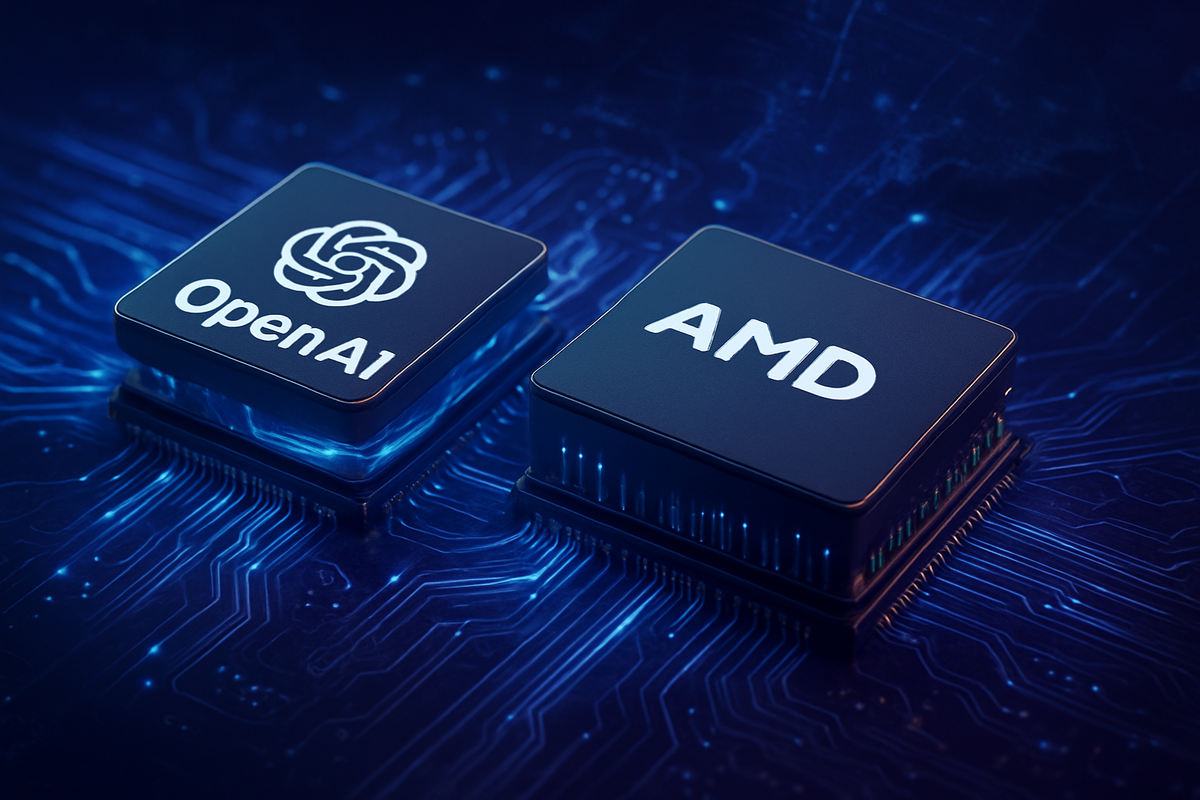The global artificial intelligence (AI) landscape is witnessing an unexpected power shift. AMD, one of the world’s leading semiconductor companies, has signed a major deal with OpenAI to strengthen collaboration in building next-generation AI infrastructure. This AMD OpenAI partnership marks a crucial step in challenging Nvidia’s long-held dominance in AI computing power, particularly in the GPU segment that drives machine learning and generative AI models.
While Nvidia remains the current leader in AI chips, this partnership signals AMD’s ambition to become a more competitive force in the rapidly expanding AI hardware market. The deal not only focuses on chip supply but also explores joint research and customized optimization for OpenAI’s model training infrastructure.
AMD’s Strategic Move To Strengthen Its AI Position
For years, AMD has been perceived as the underdog in the AI hardware race. Nvidia’s CUDA ecosystem and powerful GPUs have dominated deep learning frameworks across the world. However, with the AMD OpenAI partnership, that dynamic could begin to shift.
According to reports, AMD will provide OpenAI with advanced Instinct MI300 accelerators—chips designed to handle complex AI workloads with improved energy efficiency and scalability. These accelerators are part of AMD’s broader strategy to position itself as a strong alternative to Nvidia’s H100 GPUs, which have become the industry standard.
Lisa Su, AMD’s CEO, has consistently emphasized the company’s commitment to AI infrastructure, calling it one of the fastest-growing and most strategic markets in the world. The partnership with OpenAI provides AMD with direct access to real-world data and model optimization challenges, allowing it to refine hardware design based on OpenAI’s large-scale computing needs.
This move mirrors AMD’s earlier collaborations with major cloud service providers like Microsoft Azure, Amazon Web Services (AWS), and Google Cloud. But working directly with OpenAI gives AMD a front-row seat in one of the world’s most influential AI ecosystems.
How The Partnership Challenges Nvidia’s Dominance
Nvidia’s market capitalization surpassed USD 2 trillion earlier this year, fueled largely by its dominance in AI chip manufacturing. Its proprietary CUDA software stack gives developers tools that are deeply integrated into AI frameworks like PyTorch and TensorFlow. However, the growing demand for AI infrastructure—and the limited global GPU supply—has created opportunities for challengers.
The AMD OpenAI partnership introduces diversity into a market that has long been monopolized by Nvidia. By offering OpenAI an alternative hardware platform, AMD is helping reduce dependency on a single vendor, which has long been a concern among large-scale AI developers and cloud providers.
Moreover, AMD’s Instinct MI300 series integrates CPU and GPU capabilities into a single architecture. This hybrid design allows better memory sharing and higher data throughput—key advantages for training large language models like GPT-4 and GPT-5. Such efficiency could lead to faster training times and lower operational costs, two factors that OpenAI has been eager to optimize as it expands its product lineup.
If AMD can demonstrate comparable performance at a lower total cost of ownership, its partnership with OpenAI could set a precedent for other AI firms to diversify their hardware ecosystems away from Nvidia.
The Global Implications Of The AMD OpenAI Partnership
The significance of this collaboration extends far beyond just hardware. It represents a larger shift in how the AI industry approaches innovation, infrastructure, and supply chain strategy. With AI workloads growing exponentially, companies are rethinking how to build sustainable and scalable computing environments.
From a geopolitical perspective, the AMD OpenAI partnership also reflects the intensifying competition in semiconductor technology between the United States and other regions. As AI becomes more embedded in defense, finance, and communications, control over chip design and AI hardware has become a matter of national strategic interest.
The partnership aligns with U.S. policy goals to maintain leadership in AI and advanced computing. OpenAI, which already receives significant investment from Microsoft, now collaborates with another American chipmaker, creating a vertically integrated AI ecosystem that strengthens domestic technological sovereignty.
At the same time, this could accelerate innovation cycles globally. Competitors like Intel, Google (with its Tensor Processing Units), and new entrants from Asia are all likely to push faster development timelines to keep up. For AMD, this partnership places it squarely at the heart of the AI revolution.
What This Means For The AI Market’s Future
The AI chip market is projected to reach over USD 200 billion by 2030, driven by increasing adoption of generative AI applications across sectors like healthcare, finance, manufacturing, and autonomous systems. Nvidia has been the primary beneficiary of this boom, but that could change as more partnerships like the AMD OpenAI partnership emerge.
In the short term, Nvidia’s ecosystem remains strong due to developer loyalty and software compatibility. However, as open standards like ROCm (AMD’s open-source alternative to CUDA) mature, developers could begin exploring cross-platform optimization. OpenAI’s potential contributions to this ecosystem could accelerate such a shift.
This collaboration could also lower entry barriers for smaller AI startups that rely on OpenAI’s APIs and infrastructure. If AMD chips become more cost-efficient, downstream users could enjoy more affordable access to AI computing resources—stimulating broader innovation across the global AI landscape.
In the long run, the AMD OpenAI partnership may set the tone for a more competitive and diversified AI hardware market. It could redefine industry dynamics, inspire new alliances, and push both hardware and software innovation to unprecedented levels.
Conclusion
The partnership between AMD and OpenAI marks a pivotal moment in the evolution of the AI industry. It challenges Nvidia’s technological monopoly, injects fresh competition into the market, and underscores the importance of collaboration between chipmakers and AI developers.
By combining AMD’s hardware innovation with OpenAI’s software leadership, this collaboration could reshape the global AI infrastructure landscape—driving the next decade of intelligent computing.
Read More






 Friday, 05-12-25
Friday, 05-12-25







